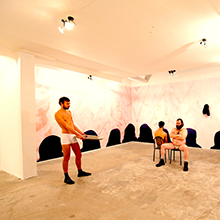
Ibrahim Quraishi (1973) is an artist who works with different mediums like photography, photo painting, video, film, installation, performance, dance and theatre. His primary interest is the exploration of the understanding of visual performativity and its relationship to the broader cultural perspective.
As a son of a former diplomat and coming from a region with a considerable amount of historical, artistic, social fluctuation over the past 1000 years and immediate familial / ancestral roots connected to Yemen, Uzbekistan and Pakistan his approach to the world is that of a traveler. Traveling is about moving and not settling down. Moving into the unknown, rather than settling in one specific place. This might explain his approach towards the different art forms and mediums. The medium is never up front at the start of a new project. The content will always determine the project and then the requested medium will be found and thus explored. Borders between the body, observed reality and the unconsciousness are often blurred in his work. The work can bring forth experiences of alienation in which an ideal body no longer knows whether it is in a real physical space or inside the fleeting image of itself.
Ibrahim Quraishi is currently represented by Galerie Lumen Travo, Amsterdam
Gabriel Smeets studied visual arts, arts history and arts journalism in the Netherlands. As an artistic advisor he created works with the Dutch theatre company Paralyse D’Amour, choreographer Krisztina de Chatel, visual artist Marina Abramovic, fashion designer Aziz Bekkaoui and artist Ibrahim Quraishi. He was the dance editor for the Dutch monthly magazine TM (Theatermaker).

Ibrahim Quraishi is interested in learning about the relationship between bodies and object inspired by the collection of Robert Wilson. Specifically he is interested in the relationship certain religious communities have to their scared rituals and how those rituals are embodied through the empowerment of their chosen objects.
In the case of Lost Codes, he will immerse himself in two local communities of the Watermill area to better understand the dynamic of rituals; specifically in the East Hampton Jewish Community and the Shaker Community.
Lost Codes is not about copying the rituals of sacred communities but will explore the importance of codes, bodies and objects inside these two specific communities. The aim is to immerse oneself in the environment and be empowered by the Jewish as well as the Shaker community to further create an installation using Robert Wilson’s objects of which many come from different religious and spiritual realms.
Lost Codes is part of our continued partnership with ArteEast.
